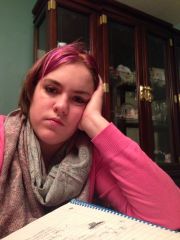![]()
![]()
![]()
Use LEFT and RIGHT arrow keys to navigate between flashcards;
Use UP and DOWN arrow keys to flip the card;
H to show hint;
A reads text to speech;
63 Cards in this Set
- Front
- Back
- 3rd side (hint)
|
Nutrition |
Process of obtaining material to convert to energy |
|
|
|
Heterophic Nutrition |
Feeds on other organisms |
|
|
|
Autotrophic Nutrition |
Make there own food |
|
|
|
Transport |
Process involved with circulation and absorption |
|
|
|
Aerobic |
Oxygen, Carbon Dioxide waste |
|
|
|
Anaerobic |
No oxygen, lactic acid waste |
|
|
|
Excretion |
Nitrogenous Waste |
|
|
|
Homeostasis |
Dynamic maintenance of a steady state |
|
|
|
Synthesis |
Producing complex substances from simple substances |
Small to Large |
|
|
Regulation |
Control and coordination of all the various activities of an organism |
|
|
|
Respiration |
C(6)H(12)O(6)+O(2)➡️CO(2)+H(2)O+ATP |
|
|
|
Photosynthesis |
CO2+H2O+Sun➡️C6H12O6+O2 |
|
|
|
Cell Membrane |
Liquid Bilayer that controls passage of material into and out of the cell |
|
|
|
Nucleus |
Controls Cell Activities |
|
|
|
Mitochondria |
Produce energy for cell (Respiration) |
|
|
|
Endoplasmic Reticulum |
Moves materials through cell |
|
|
|
Ribosomes |
Produce proteins from amino acids |
|
|
|
Golgi Bodies |
Make, package and secrete cell products |
|
|
|
Vacuoles |
Store materials |
|
|
|
Lysosomes |
Contain digestive enzymes in unicellular organisms |
|
|
|
Centrioles |
Mainly animal cells Mitosis and Meiosis |
|
|
|
Cell Wall |
Plant cells, made of glucose |
|
|
|
Chloroplasts |
Plant Cells, trap light energy |
|
|
|
Atoms |
Chemical building blocks Protons, Neutrons, Electrons |
|
|
|
Organic |
Carbon and usually hydrogen |
|
|
|
Inorganic |
No carbon combined with hydrogen |
|
|
|
Lipids |
Composed of fatty acids and Glycerol Carbon, hydrogen and nitrogen |
|
|
|
Proteins |
Made of Amino Acids Building material |
|
|
|
Catalysts |
Always made of proteins/amino acids |
|
|
|
Vitamins |
Help chemical reactions occur |
With Enzymes |
|
|
Vitamins |
Act as coenzymes |
|
|
|
Mechanical Digestion |
Chewing food |
|
|
|
Chemical Digestion |
Saliva |
|
|
|
Esophagus |
Tube to stomach |
|
|
|
Peristalsis |
Pushes food through digestive system |
|
|
|
Studying |
BORING!!! 😴😲 |

|
|
|
Stomach |
Hydrochloric Acid Ulcers Heart burn |
|
|
|
Small Intestine |
Most of digestion |
|
|
|
Appendix |
Between small and large intestine |
|
|
|
Large Intestine |
Absorbs excess water |
|
|
|
Rectum and Anus |
Storage of feces Peristalsis Egestion |
|
|
|
Order of circulation |
Lungs➡️Left➡️Left↩️ Right⬅️Right⬅️Body↩️ |
|
|
|
Platelets |
Clots the blood |
|
|
|
Plasma |
Liquid part of blood |
|
|
|
Virus |
Antibiotics |
|
|
|
Virus |
No help from antibiotics because VIRUSES AREN'T LIVING |
|
|
|
Oxygenated |
Left ventricle Vena Cava |
|
|
|
Deoxygenated |
Pulmonary Vein Right Atrium |
|
|
|
Medulla Oblongata |
Breathing control in brain |
|
|
|
Liver |
Produces Urea from amino group |
|
|
|
Kidneys |
Filter Urea |
|
|
|
Nephrons |
Filtering Unit in Kidneys I million in each kidney |
|
|
|
Nervous system |
Acts quickly Short term results |
|
|
|
Endocrine system |
Acts slowly Long term results |
|
|
|
Senses |
Detect stimuli |
|
|
|
Neurons |
Transmit an impulse |
|
|
|
Neurotransmitters |
Chemicals that cross the synapse and combine with receptors on next neuron |
|
|
|
Acetylcholine |
Slows heart, speeds digestive, skeletal |
|
|
|
Noradrenaline |
Speeds heart, slows digestive, no skeletal |
|
|
|
Pancreas and Insulin |
Stimulates glucose uptake by cells |
|
|
|
Ovaries |
Estrogen |
|
|
|
Testes |
Testosterone |
|
|
|
Locomotion |
Interaction of muscles |
|

